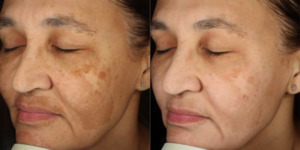by Skincare Specialist, Kim van Zyl
With all the changes your body goes through during your pregnancy, it seems a bit unfair that Mother Nature would find it thinkable to throw something else into the mix. Called “the mask of pregnancy,” melasma is, unfortunately, the reality for many new moms. For me, having Melasma definitely dampened that signature pregnancy glow. It was difficult enough being pregnant with an enormous belly and sore back, so having to have dealt with brown blotches on my face felt like just too much. For a lucky few, Melasma can go away a few months after pregnancy, unfortunately, mine was here to stay. Being a Skincare Specialist with a love for depigmentation, I was fortunate enough to have access to world-class Melasma treatments (and results).
Table of contents
- WHAT IS MELASMA?
- HOW IS MELASMA DIAGNOSED?
- CAN MEN GET MELASMA?
- THE DIFFERENCE BETWEEN MELASMA AND
HYPERPIGMENTATION - TYPES OF HYPERPIGMENTATION
- TREATMENTS FOR MELASMA
- WHEN WILL I SEE MELASMA TREATMENT RESULTS?
- ARE MELASMA TREATMENT RESULTS PERMANENT?
- OUR APPROACH TO TREATING MELASMA
WHAT IS MELASMA?
Melasma is often referred to as “the mask of pregnancy,” as pregnant women are much more likely to have this condition. It is a condition in which brown patches appear on the face. The brown or grey-brown patches of melasma appear most often on the cheeks, forehead, nose, and chin. Melasma can also be seen in other parts of the body, typically those prone to more sun exposure, such as the shoulders and neck. While not dangerous, having this form of pigmentation can definitely give your self-confidence a knock.
HOW IS MELASMA DIAGNOSED?
It seems like a Melasma diagnosis would be pretty straightforward, but it can be easy to confuse it with other conditions like post-inflammatory hyperpigmentation (brown spots left behind by a skin injury like acne), At Dr. Nerina Wilkinson + Associates, we use world-renowned technology (including a VISIA Skin Analysis) to look at the deeper layers of your skin to determine what form of pigment you have.
Some visible characteristics of Melasma that we look out for are:
- Pigmented symmetry, with matching marks on both sides of the face
- The appearance on very particular areas of the face like the cheeks, forehead, chin, and upper lip
- The signature brown or greyish, mask-like patches.
CAN MEN GET MELASMA?
Yes, although Melasma is more common in women, men can also be affected by Melasma, and as for women it also negatively affects their quality of life and self-confidence in men. Melasma generally also has similar manifestations in men and women. With men, family history, sun exposure, photo-sensitizing medications, and skin care products are all culprits among the triggers for Melasma.
THE DIFFERENCE BETWEEN MELASMA AND HYPERPIGMENTATION
They look the same and act the same and can even be caused by similar things! But the difference between melasma and hyperpigmentation may be more complicated than you might think… The efficacy of treatment for either of these conditions stems from a deep understanding of each.
Understanding Melasma
Melasma is a form of hyperpigmentation, yes, but can be triggered by many different factors. This is what distinguishes it from traditional hyperpigmentation. Melasma is caused by the production of melanocyte-stimulating hormone (MSH). The pigment-producing cells within the skin are known as melanocytes. MSH will activate the melanocytes which cause skin discoloration. There are numerous factors that can stimulate MSH including heat, stress, dehydration, obesity, and sun exposure. Due to this, it can be difficult to treat Melasma because some triggers (such as stress and heat) can be hard to avoid. Estrogen and progesterone sensitivity are also associated with this condition. This means that birth control pills, pregnancy, and hormone therapy can all trigger Melasma.
Understanding Hyperpigmentation
Hyperpigmentation is not necessarily its own condition but an umbrella term that describes the darkening of the skin. Hyperpigmentation can present itself all over the body, in a few large areas, or small patches. Patches of skin become darker in colour than the normal surrounding skin. This darkening occurs when an excess of melanin, the brown pigment that produces normal skin colour, forms deposits in the skin
TYPES OF HYPERPIGMENTATION
Post-inflammatory hyperpigmentation
This condition results from inflammation or an injury to the skin. Acne is a very common cause of this type of hyperpigmentation with the dark spots it can leave behind on the skin.
Sunspots
These dark spots on the skin are also called liver spots. They’re usually the result of excessive exposure to the UV rays of the sun over time. They appear on areas often exposed to the sun such as the face and hands.
TREATMENTS FOR MELASMA
CAN MELASMA BE TREATED SUCCESSFULLY?
The most important rule when it comes to treating Melasma is to know that it cannot be cured, it can only be improved after which we can only work on maintaining results. At Dr. Nerina Wilkinson + Associates, we have however seen life changing results with the following depigmenting treatments
Cosmelan and Dermamelan
Cosmelan and Dermamelan are clinical topical treatments specifically formulated to not only depigment the skin at surface level but also treat underlying causes. These treatments are considered the gold standard treatment for melasma and other pigmentation conditions worldwide. Cosmelan and Dermamelan effectively remove and lighten dark patches, resulting in a brighter, smoother, and more even complexion.
Mesoestetic Melan Tran3x
Mesoestetic’s Melan Tran3x is an innovative, modular program that combines several treatment categories into one treatment session for a flexible, integral depigmentation action that allows acting on hyperpigmentation at several depths. It allows combining different methods to modulate depigmenting intensity. MelanTran3x is suitable for treatment for less severe pigmentation and is also used as maintenance after Cosmelan or Dermamelan.
WHEN WILL I SEE MELASMA TREATMENT RESULTS?
Results will differ from patient to patient and treatment plan to treatment plan, as we are all beautifully unique. With Cosmelan and Dermamelan we normally start seeing an improvement in pigment after one month. With Melan Tran3x improvement can be seen after the 3rd treatment. It is important to remember, however, that both of these treatments will need to be accompanied by a strict home care regime in order to maintain results. These are not once-off solutions…
ARE MELASMA TREATMENT RESULTS PERMANENT?
No, at present there is no cure for Melasma, but there are several treatment options that may improve the appearance. Results can be maintained with a good at-home pigment inhibitor product (such as Mesoestetic’s Melan Tran3x Concentrate and Melan Tran3x Gel Cream), sunblock (Melanprotech 130+), and maintenance treatments (fruit acid peel and the signature 3D Bespoke). If Melasma occurs during pregnancy, it may go away a few months after delivery and treatment may not be necessary – though it may come back during another pregnancy or strong hormonal changes within the body.
OUR APPROACH TO TREATING MELASMA
Melasma and other forms of hyperpigmentation are the most treated skin conditions in our clinic and we have therefore done intense research on treating and improving them. As depigmentation specialists, we know that we always need to start a depigmentation journey with an in-depth analysis in order to create a customised blueprint to target each patient’s concern specifically. Only in doing so, we can achieve optimal results.
Should you suffer from Melasma or other forms of hyperpigmentation and are ready to make a change, email us at skinclinic@drnwilkinson.co.za to start your Skin Science journey to radiance today.
Written by Skincare Specialist, Kim van Zyl





